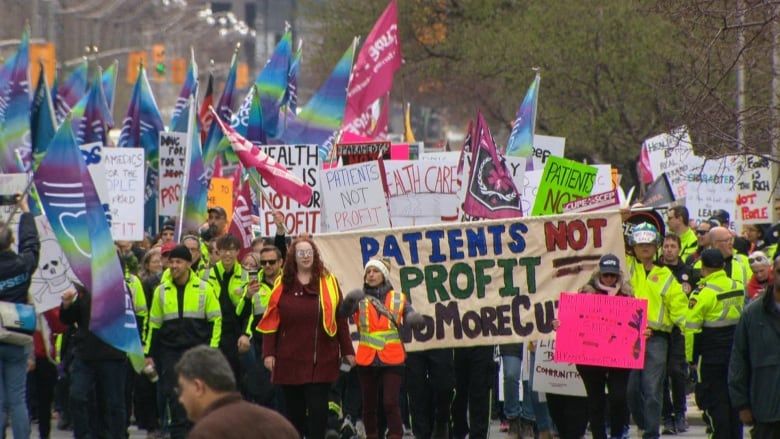
In early April, hundreds of thousands of students, teachers and education workers protested against Doug Ford’s attacks on education. At the end of April, 8,000 health care workers and their allies rallied at Queen’s Park, the seat of the Ontario legislature, in Toronto. This was hosted by the Ontario Health Coalition, an umbrella group representing unions and community groups.
The main focus of the rally was opposition to Bill 74, which has the fuller, more Orwellian name of The People’s Healthcare Act. As the website Rank and File points out, the Bill “proposes a mass merger of health agencies into one giant bureaucracy, giving the Health Minister major new powers to ‘integrate’ healthcare—including to ‘partner with another person or entity’ (ie privatization) and ‘to cease to operate or to dissolve or wind up the operations’ (i.e. cuts).”
Ford, the self-proclaimed man of the people, was elected on his Plan for the People which would supposedly “end hallway medicine by creating 15,000 new long-term care beds over the next five years and add $3.8 billion in new support for mental health, addictions and housing.” Yet one of the first things Ford did was to cut the planned $300m increase in mental health care funding by half.
He set up a fancy sounding group called the Premier’s Council on Improving Healthcare and Ending Hallway Medicine. It released its first report in January, Hallway Health Care: a System Under Strain and it began by stating that “the system is facing capacity pressures” without any reference to decades of cuts that have left Ontario with the lowest number of hospital beds per capita of any province – and one of the lowest of any industrialized country. Instead it blames demographics, specifically the growing number of elderly and general population growth.
Providing more long-term care beds is fundamental to ending hallway medicine. There is an immediate need for about 5,000 such beds. With Ontario’s population over 75 years old growing at 4% to 5% annually, 15,000 new nursing home beds are needed over the next four years and a continued expansion of home-care services to eliminate the problem.
https://www.msn.com/en-ca/news/canada/are-private-home-care-companies-about-to-become-more-profitable/ar-BBTB20A
The Premier’s Council is headed by Reuben Devlin, who was president of the Ontario Conservative Party during the Harris health care cuts. Of the 11 members of the Premier’s Council, two are current CEOs of private home-care companies and a third is a former chair of a private home-care company. Not surprisingly, the website of Home Care Ontario, an organization representing private home care providers across the province, stated that they welcomed the report of the Premier’s Council. Bill 74 envisages the dissolution of all 14 of the province’s Local Health Integration Networks into a single agency and it is highly likely that the private companies that provide more than 95% of Ontario home-care are going to be supervised more loosely, by this one government agency.
As the former Deputy Minister of Health pointed out, “For each home-care visit made by a personal support worker, the company gets $34. The worker gets $17 to $19. Even with employment benefits worth about 18% of pay, these companies are achieving at least a 20% profit margin with no risk of bad debts since their client is the taxpayer of Ontario. These companies increase their profit margin even further if they can shift more vulnerable Ontarians from a publicly-funded to a private model of care. The companies have grown from small organizations to diversified profit generators. They even provide international consulting services that are focused on maximizing profits as the richest generation in the world’s history ages and requires help at home. The home-care industry may be about to enter a golden era of profitability in Ontario.”
Rank and File points out that the obvious solution to the problem “of insufficient beds would be to restore public funding and re-open all the closed hospitals and beds. The report from the Premier’s Council rejects this—stating twice that ‘simply adding more beds to the system will not solve the problem of hallway health care.’ And the report’s solution? ‘A focused effort to consider technology solutions. This could look like new partnerships to deliver specific services.’” In other words, privatization.
Ford no fan of Preventative Medicine
The Premier’s Council report pays lip service, three lines, to the concept of “social determinants of health” but is blissfully unaware of the impact of government policies on them. Research done in Hamilton, Ontario about 5 years ago illustrates the problem.
Researchers looked at life and death in 135 Hamilton neighbourhoods and census tracts and, when they broke it down by income, found some shocking disparities. If someone was born in the city’s poorest neighbourhood, they would die at 65.5 years of age. If they lived five kilometres away in Hamilton’s leafy suburbs, they tended to live beyond 86 years.
Doctors can only do so much for a person’s lifespan. Around 25% of a person’s state of health and longevity is something you can attribute to doctors, hospitals and the health care system. Fully half of how long you live and how well you live is attributable to your education, your income, the type of housing you live in and whether you grew up in a single parent family or have a strong social network. The single best advice for a long life – do not be poor..
This is another way of saying that capitalism kills. And the connection to Doug Ford? Well, his government stopped the minimum wage going up to the scheduled $15 and took away the two annual paid sick days and fair scheduling provisions that were brought in by the previous Liberal government. Impoverishing already poorly paid workers and taking away their paid sick days may boost the short-term profits of businesses, but it will only exacerbate the health problems of a significant section of the working class. As the Rank and File article points out, “cancelling the $15 minimum wage makes it more difficult for low-income workers to access healthy food, safe shelter and prescription medication – and more likely they will end up in hospital. Revoking two paid sick days makes it more likely that workers will go to work sick or send their kids to school sick – which will make it more likely that infectious diseases will spread – and more likely that they will go Emergency rather than their primary health provider on a work day. Revoking fair scheduling makes precarious work more stressful – which takes a toll on mental health. Bringing back sick notes drives people unnecessarily into doctor offices and ERs, creating more crowding.”
The Ontario Health Coalition is to be congratulated for the rally. Taken with the earlier protest by students teachers and education workers, there is the potential now to develop a strong union based movement that can recover the best traditions of the Days of Action protests during the Mike Harris years of the 1990s. But it must extend beyond the unions. It needs to reach out to the vast numbers of low paid, non-unionized, precarious workers.
Socialist Alternative campaigns for:
- Fight the cuts – restore full funding to hospitals
- Fight Privatization – no two-tier health service
- For a full, universal pharmacare program
- Support the struggle for decent well paid jobs, affordable housing, free public transit and cheap nutritional food
- For a socialist society, one that can finally put an end to socially determined, early death.


